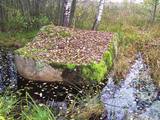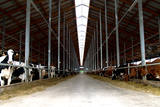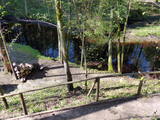| Nr | Name | Beschreibung |
|---|---|---|
|
Platais Boulder (Wide boulder). You can find it in the rural municipality of Mākoņkalns not far from a
small meadow close to the boulder of Āžmugura. Both the boulders have their legends. Some say that the
boulder of Āžmugura is the part of Platais boulder and the rainwater from its cavity heals the warts.
|
||
|
Diese Schmalspurbahn ist eine schöne Möglichkeit, zurück in die Vergangenheit zu kehren – in die Zeit, wenn auf dem Territorium Lettland eine Epoche der Schmalspurbahnen “herrschte”. Bis zu den 60er Jahren des vorigen Jahrhunderts war die Schmalspurbahn an der Küste von Nordkurland im Einsatz und verband die an der Küste liegenden Fischerdörfer. Bis heutzutage sind die Orte (nur kaum erkennbare Korridore im Hintergrund der Natur), einzelne Stationsgebäude oder die Reste erhalten. Im Freilichtmuseum von Ventspils kann man die 1,4 km lange Ringlinie oder 3 km Berglinie interessant fahren. Am Ende der Berglinie befindet sich eine Drehscheibe. Die Lokomotive der Schmalspurbahn ist 1916 in Deutschland gebaut worden. Man kann auch ein Stationsgebäude mit ganzer Ausrüstung besichtigen. |
||
|
The owner of the venue makes homemade wine on the basis of traditions that have been handed down from generation to generation. You can taste four different wines along with snacks and engage in philosophical discussions about winemaking recipes. You can also buy the wines. |
||
|
Die Agrofirma Tērvete AG ist das größte Mehrzweigunternehmen für Landwirtschaft in Lettland, das sechs Bereiche umfasst: Obstbau, Milchviehzucht, Pferdezucht, Verpflegung, Biogasherstellung und Bierherstellung. |
||
|
"Sabiles laivas" Talsu novadā piedāvā laivu nomu, laivu un laivotāju transportu. |
||
|
Bereits 1615 teilte der kurländische Herzog Friedrich Kettler der Stadt Bauska das Privileg für den Bau eines neuen Rathauses zu, was dann im 17.Jh. auch verwirklicht wurde. Der Marktplatz konnte nun stolz das größte Rathaus im ganzen Herzogtum vorweisen. Aus Geldmangel wurde 1852 dessen Turm abgebaut, 1871 das obere Stockwerk. 2011 wurde der Bau des neuen Rathauses endlich abgeschlossen, und Bauska kann nun wieder stolz auf ein neues, hervorragendes Touristik-Objekt sein, das auch von innen besichtigt werden kann. Im erneuerten Rathaus kann man sich in alten Maßeinheiten messen und wiegen lassen, in Ellen und Fuß, in Pud (ein altes russisches Gewichtsmaß, A.d.Ü.) und in Pfund, und dafür eine entsprechende Urkunde erhalten. |
||
|
Dieses Schloss wurde von 1878 bis 1881 (Baumeister Jānis Meņģelis; deutsch ist Sigulda Segewold) gebaut. Der Inhaber war der Fürst Kropotkin. Im Jahr 1937 wurde der Schlossturm erhöht (Architekt Alfrēds Birkhāns). Von 1923 bis 1940 befand sich in dem Gebäude das sogenannte Schloss der Schriftsteller (die Wirtschaft hat hier damals die Lettische Pressegesellschaft geführt), aber während der Sowjetzeit – ein kardiologisches Sanatorium. Im Jahr 1993 zog in das Schloss die Stadtverwaltung von Sigulda ein, seit 2003 befindet sich hier die Kreisverwaltung von Sigulda. In dem Landgutkomplex haben sich ein Wohnhaus aus Holz (Mitte des 19. Jhs.), wo die Familie von Kropotkin wohnte, eine Kornkammer (Jahrhundertwende 18.-19. Jh.), ein Gartenhaus (19. Jh.) und ein gemauerter Zaun (19. Jh.) erhalten. Das Neue Schloss von Sigulda, genauso wie die Burgruinen von Sigulda und Krimulda, das Landgut von Krimulda und die Burg von Turaida gehören zum Komplex der historischen Zentren von Sigulda, Turaida und Krimulda. |
||
|
Das Volkshaus von Lapmežciems–
gebaut 1957.
|
||
|
Pie Gārsenes pils atrodas bijušais muižas parks 4ha platībā un pie tā sākas arī Gārsenes dabas takas. Dabas takas vēsturiski tika veidotas vienlaicīgi ar pils kompleksa būvniecību un ieeja takās atrodama pie mākslīgi veidotā, ar bruģa pamatni izliktā barona peldēšanās dīķa. Takas sākumā saglabājusies ošu aleja, ko savulaik stādījis barona dārznieks, savukārt taku vidusposmā apmeklētājiem ir iespēja pasēdēt uz Barona krēsla - akmens ar cilvēku veidotu sēdvietu tajā. Kopumā Gārsenes mežā vijas dažāda garuma labiekārtotas pastaigu un izziņas takas - Kultūrvēsturiskā taka, Zaļā taka, Baronu pastaigu taka, Staburaga taka, ar ierīkotām atpūtas un ugunskuru vietām. Takās apskatāmi vairāk kā 40 unikāli dabas objekti, gan dižakmeņi, gan dižkoki, kā arī un pagasta ievērojamākie arhitektūras un kultūrvēstures pieminekļi. No 2016.gada maija Dabas takās ietilpst arī „Krēslas stundas taka”, kas īpaši patiks zinātkāriem mazajiem ceļotājiem. Taka stāsta par Rūķu dzīvi mežā un tās veidošanas pamatā ir stāsti no „Lielās Rūķu enciklopēdijas”. |
||
|
Der Bauernhof Uibo bietet seinen Gästen frische Schweinefleischgerichte an, die möglichst wenig Konservierungsmittel und Zusatzstoffe beinhalten und einen typisch nationalen estnischen Geschmack aufweisen. |
||
|
Auf dieser Tour lernen Sie die schönsten Orte und Städte der Region Vidzeme und des Gauja-Nationalparks, wie Sigulda und das Gauja-Tal, die mittelalterliche Altstadt von Cēsis und die Kleinstadt Valmiera kennen. Sie werden das „Mittagessen des Müllers“ in einer noch in Betrieb befindlichen Windmühle zu sich nehmen, einen Kräuter- und Gemüsegarten an einer mittelalterlichen Burg erkunden, Hanfbutter probieren und das regionale Bier „Valmiermuiža“ verkosten. Sie Probieren Sie den grünen Käse testen ein sprudelndes Birkensaftgetränk und können Köstlichkeiten aus Knoblauch erstehen. |
||
|
Saimniecībā "Jauncaunes", Ogres novadā, grupām, kā arī individuāliem apmeklētājiem tiek piedāvāta atpūta brīvā dabā, iepazīstot un izmēģinot metamos ieročus, šaušanu ar dažāda veida lokiem, arbaletiem un pneimatiku. |
||
|
Der Gebrüderfriedhof von Lāčukrogs –
Friedhof für die im Ersten Weltkrieg
Gefallenen.
|
||
|
Latvia’s highest hill is the second highest in the Baltic States, but alas, it has only a wrecked viewing tower, so you’ll have to look for the best views on your own. You’ll find some around the tower and the ski trails, particularly Large and Small Golgotha. It is worth hiking the Gaiziņkalns nature trail.
|
||
|
The restaurant – pizzeria Tomato Pica is situated in the centre of the city of Jelgava, in the shopping centre Pilsetas Pasaza. Elegant and comfortable restaurant premises for enjoying your food, soft music in the background and polite, professional servers. Tomato Pica offers all classical types of pizza, baked using special sauce recipes and dough typical for Italy, as well as different salads, appetizers, desserts and drinks. The restaurant –cafe Tomato Pica is suitable both for family rest and for business lunches. |
||
|
Namdaris Rinalds Dundurs būvē, atjauno un restaurē vecās koka ēkas. Veido nestandarta masīvkoka mēbeles, bērnu rotaļlietas un lampas. Darbus veic sadarbojoties ar Latvijas dizaineriem. |
||
|
The farmstead grows apples, strawberries, black currants, red currants, etc., berries and fruits; there is a big selection of processed goods: natural juices, nectars and syrups. There are offered apple, strawberry, red currant, gooseberry, sea-buckthorn and chokeberry saplings; consultations are given for making out a commercial garden and taking care of it. Excursions around the commercially grown plants. |
||
|
Traķu pussalas pils austrumu mūrim pieguļ ar mežu apaudzis iespaidīgs pilskalns (uzved koka kāpnes) – t.s. Upurkalns, kurā pirms mūra pils celtniecības stāvējusi koka pils. 1779. g. dominikāņu mūki sagrautās Pussalas pils vietā uzsāka baznīcas celtniecību. Jau vēlāk – 1822. – 1823. g. vienā tās daļā uzcēla dominikāņu klosteri, bet otrā – kapelu. 1990. g. šeit izvietoja Traķu vēstures muzeja administrāciju, bet 2005. g. kapelā izveidoja Sakrālās mākslas izstādi. 2011. g. ēku kompleksā notika vērienīgi rekonstrukcijas darbi. |
||
|
Jau no seniem laikiem Cesvainē zinājuši alu, vīnu un brandvīnu. Pirmais krogs minēts jau pirms 1520.gada. Cesvaine var lepoties ar savulaik lielāko un svarīgāko krogu Vidzemē - Šļākas krogu. Barona Vulfa pils pagrabi vienmēr bijuši pilni ar labām vīna, liķiera un brandvīna pudelēm. |
||
|
Das Café befindet sich im Zentrum von Kandava, unweit von dem Marktplatz. Gebäck, Kuchen, Torten, traditionelles Gericht Sklandrausis, Piroggen u.a. |
||





























